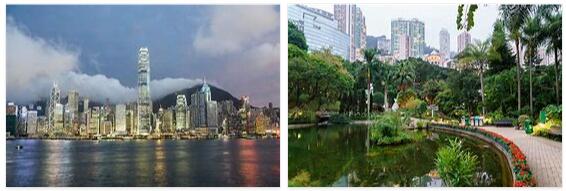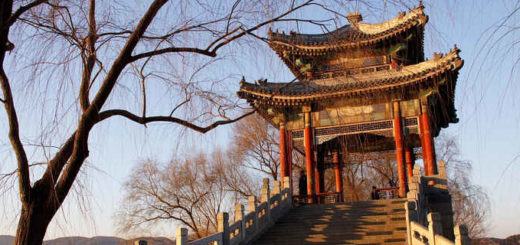Landmarks in Hong Kong
Hong Kong is China in a special form, because on the one hand it is the large, lively, loud, cosmopolitan, chic metropolis, on the other hand it is a special administrative zone on the south coast of the People’s Republic that only gained independence in mid-1997. Until then, Hong Kong, which today presents itself as one of the leading financial and trading centers in Asia, was a British crown colony, and before that it was an insignificant fishing community until the 19th century. In addition to the actual peninsula, Hong Kong also includes over 250 offshore islands in the South China Sea, of which Hong Kong Island, Lantau, Cheung Chau, Peng Chau, Lamma and Tsing Yi are the best known. There is a lot to see in this region and very different things … in the approx. 25% urban area as well as in the rural areas. In Hong Kong, West meets East, and modernity and tradition often form great contrasts. You will encounter tradition, for example, with the Western Market, the oldest market in the city, considerable Taoist temples, the Po Lin Monastery with Tian Tan Buddha as the largest Buddha statue in the world or in the Hong Kong Museum of Art. And a trip on the traditional Star Ferry from Victoria Island to the Kowloon Peninsula allows a view of the modern skyline. In terms of landscape, Hong Kong, on the other hand, is relatively homogeneous due to its almost consistently mountainous relief. Larger plains are only found in the northern parts of the New Territories. The most important natural sight is the Victoria Peak with 552 m height, directly behind the Central District. A ride on the cable car to the viewing platform offers a fantastic view as well as opportunities for shopping in the “Peak Galleria” shopping center, which is unusual due to its location. In the immediate vicinity there is also Statue Square as a small island of tranquility between the countless sights, diverse cultural events, shopping opportunities, etc.
Victoria Peak Hong Kong
The 552 m high Victoria Peak is Hong Kong’s local mountain and the highest point on Hong Kong Island. Its Chinese name (Tai Ping Shan) means “mountain of great peace”. The most exclusive residential area of the city has stretched on its slopes since colonial times. At that time the British were drawn here mainly because of the pleasantly cooler temperatures, today the local residents particularly appreciate the impressive view of the harbor and the surrounding area. The real estate prices on Victoria Peak are now astronomical and it goes without saying that “the higher, the more expensive”. Victoria Peak has become one of the area’s most popular attractions over the years.
A special experience is the ride on the historic cable car, the Peak Tram, which was put into service in 1888. At peak times, however, the visitor has to be prepared for a relatively long waiting time. At the valley station, those interested can find out more about the history and technical details of the lift in a small gallery.
The summit is dominated by the anvil-shaped Peak Tower, in which there are several souvenir shops and restaurants as well as an original Madame Tussauds wax museum. If you want to enjoy the view from various vantage points, you have the opportunity to experience it on a well-signposted circular route, the 3.5 km long Peak Circle Walk.
The “Sky Terrace”, which is only accessible with a separate ticket, offers a breathtaking 360 degree view of the skyline of one of the most impressive cities in the world. During the day, the skyscrapers glitter in the sunlight, while in the dark they appear as a shimmering sea of lights.
A visit to Victoria Peak should not be missing on any visit to Hong Kong.
Stanley Market
Stanley Market is one of the many must-go spots for tourists when visiting Hong Kong on a trip. There is an interesting selection of small shops selling silk clothes, sportswear, art, Chinese costume jewelry and souvenirs.
Shopping at Stanley Market in Hong Kong has been popular for decades. And while tourists are still flocking, the market and the tiny seaside town of Stanley have managed to keep this quaint little town and laid-back lifestyle alive. Stanley Market and Village are located in the southern part of Hong Kong Island and are 45-50 minutes by bus from downtown. Visitors will see the market first as they approach the small town.
Visitors should take the time to stroll through the small alleys of the famous market. The area is covered, many shops are air-conditioned and the atmosphere is certainly less chaotic than in other large markets. Holidaymakers will find a variety of products here, from clothing, handbags and suitcases, paintings and clocks to small electronics and Chinese souvenirs such as lanterns and kites for those who stayed at home.
Prices are negotiable as in all markets in Hong Kong and this is a great place to hone your negotiating skills.
Those who need a break from shopping can get delicious snacks and cool drinks in one of the many local restaurants on the market. The food is great and cheap, and many vacationers have found new favorites here. Since there are many things to see and do in Stanley, and most attractions are best enjoyed during the day, it is best to get up early and not arrive late in the morning.
Star Ferry in Hong Kong
They are painted green and white and have had pretty names since they were baptized: Morning Star, Eastern Star or Twinkling Star. They are always “stars” because the small and agile ships of the Ferry Line are an important means of transport in Hong Kong. They connect the districts of Kowloon and Hong Kong Island. The crossing takes only ten minutes, which many visitors to the metropolis regret, because the view of the skyline is terrific. Especially if you as a passenger have opted for Upper Class on the first floor.
For twenty cents from pier to pier
The former Kowloon Ferry Company first sent their ferries on the short voyage in 1888. Since then, they have been firmly anchored in people’s everyday consciousness at the mouth of the Pearl River. You can hardly imagine a life without your “Ferry”. Although the Gross Harbor Tunnel has connected the two most important districts of Hong Kong since 1972, the ferries, which are reminiscent of the colonial days, still carry around 70,000 passengers from pier to pier every day. The fleet has now grown to twelve boats with 550 seats each. The boats run every minute, and a passage costs the equivalent of 20 cents.
A typhoon destroyed the pier
In addition to the now aging tram, the Star Ferry is the most popular means of transport in Hong Kong. The passenger receives tickets at a machine, whereupon a barrier to the ship opens for him. Time is money in this city – and that is why the ferry connection procedure was revolutionized years ago. Only twice in its history has the company been forced to stop its ferry services. In 1906 the Kowloons wharfs were destroyed by a typhoon and in 1941 the Japanese invasion forced a break of three and a half years. In 1961, the ferries even formed the backdrop for a classic film. Several episodes of “The World of Suzie Wong” were filmed on the deck of the Ferrys.



